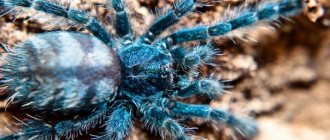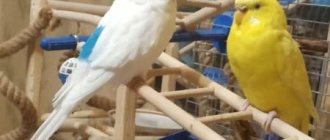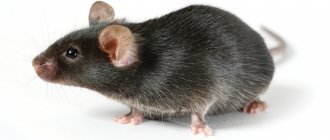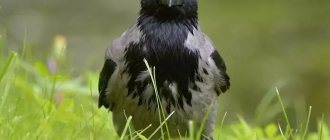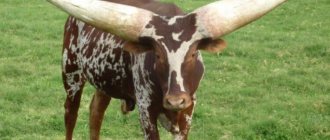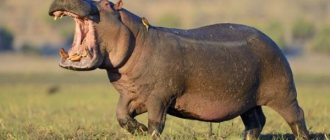- Description of the spider
- Predator's net
- How do house spiders feed?
- Haymakers
- Small gray and black house spiders
- Hobo Spider
- Curious racers
- Southern white karakurt spider
- How to get rid of house spiders in the apartment and in the house
- Signs for a spider
- Conclusion
The spider is an arthropod. A person has already become accustomed to their presence in the house. House spiders are quite numerous in variety - there are 42 thousand species of these representatives of the arachnid class in the world. On Russian territory there are 3 thousand studied species, the distinctive feature of which is the weaving of snares (webs). These webs contain food for the spider: insects.
Interestingly, there are some superstitions associated with spiders, and some hobbyists keep spiders as pets.
Description of the spider
The spider has 4 pairs of visible legs and 2 more pairs – jaws and “arms”. The limbs are attached to the cephalothorax, followed by the abdomen. Spiders living in the house have 16 eyes on their heads. Spiders are predators because they feed on live insects and do not refuse to dine on small arthropods. They don't pay attention to dead insects.
The presence of a spider in the house is revealed by woven webs in corners and under furniture. For housing, these insects choose secluded, dry and warm corners where their owners will not see them and where the sun’s rays do not reach them. Some spiders like humidity and coolness.
The life of domestic spiders is short - 1 year. Female tarantula spiders live up to 35 years, while males live for 2-3 years.
Varieties
There are three main species of Loxosceles reclusa, as this species of arthropod sounds in Latin.
Brown
The most common variety. They originally lived in Latin America, from where they spread throughout the world since the 70s of the last century. They adapted to the conditions of existence next to humans.
Brown
Chilean subspecies. Less poisonous, common in Chile and Hawaii.
Mediterranean hermit spiders, distinguished by their red-brown or yellowish color, live in the southern latitudes of Europe and Russia. The degree of danger of the poison of this species of arthropod needs additional study.
Predator's net
When hearing the word “spider,” a person immediately imagines an openwork web or dense snares. The spider weaves a web using a solidifying liquid substance found in the arachnoid glands located inside the abdomen. A sticky mass is released from arachnoid warts. The threads of the web woven by a spider are thin webs glued together from several different glands.
Spiders use webs:
- for catching prey;
- for creating a cocoon around the masonry;
- burrowing spiders line their dug-out dwellings with soft webs;
- In the autumn, young spiders use long threads from the web for migration.
Reproduction
Tegenaria domestica leads a solitary lifestyle and gathers in pairs only during the mating period. The male looks for the female’s web, carefully approaches, and pulls the threads. The female, at the sight of the “suitor,” either rushes to attack or sits motionless in the center of the funnel. The second option means that the lady is ready to accept the gentleman. After mating, the couple remains together for some time. Then the most important thing for the male is to leave in a timely manner, otherwise he will simply be devoured.
After a few days, the female begins to weave a cocoon from the web, lays eggs there, and hangs it from the funnel, where she herself lives. The cubs develop in about 20 days, during which time the tegenaria protects them. About 50 spiders are born. They stay together for about 2 weeks, their mother feeds them, then they scatter in different directions.
Haymakers
Haymakers, also known as centipedes, also known as window spiders, are red or brown house spiders, with a small 1 cm dark abdomen and long 5 cm legs. They weave cobwebs into the corners of rooms and love to bask where the sun warms them.
The haymaker is not dangerous for people - it will attack only if frightened, but more often it runs away. They enter houses during cold spells at night. In summer and autumn, the female lays eggs and entangles them in a web. After 14-20 days, light-colored small spiders emerge.
A damp spring cleaning will help drive out unwanted tenants.
Spider love games
Being smaller in size than the female, the potential groom must be extremely careful and tactful in courtship, otherwise he may get kicked or even risk being killed by an angry passion. He takes small steps towards her along the web, watching her reaction. If everything is calm, then the spider crawls up to the spider at an intimate distance and places its foot on her leg.
Small gray and black house spiders
A common type of house spider. The body length of males is usually 1.4 cm, the length of a female with legs spread is 3 cm. Females go hunting at night, whose net is compared to a pipe. In summer they are found in trees, and the wind blows spiders into the house through an open window or vent.
Gray house spiders also crawl on their own along the wall, hiding in corners and behind furniture. They bite in case of defense during an attack. The lifespan of adult females is 2 years, and males live less than a year. In winter they sleep more often. If you do a thorough wet cleaning, the spiders will go away.
Lifestyle
The house spider sits in a secluded place during the day, hides away from the sun's rays, and goes out hunting at night. Uses trapping nets or does without them. In the first case, the spider pounces on prey that accidentally gets entangled in the web. The predator injects poison, its own saliva. The first substance paralyzes the victim, the second liquefies the insides, which are then sucked out by the house spider. After some time, he throws the funnel and forms a new one in another place.
House spider (Tegenaria domestica)
The second method of hunting also involves the use of cobwebs, but without trapping nets. The spider stretches only 2 thin threads and sits in a secluded place. As soon as the prey touches them, the predator rushes to attack with lightning speed. The main diet consists of flies, fruit flies, mosquitoes, wasps, bees, as well as cockroaches and ants.
Interesting!
House spiders sense changes in atmospheric pressure very well. Before the rain, they climb deeper into the hole, sit there, without sticking out, and before a sunny day, they weave trapping nets all night.
Hobo Spider
These spiders, which are not dangerous to humans, enter homes through a window or door. In appearance, with their thin long legs, they are similar to harvestmen, but the paws have dark stripes. The oval, slightly flattened body is brown in color.
These are fast-running predators, hunt at night, and do not spin webs. They wait for prey, hiding, and rush at the right moment, injecting poison. Immediately after destroying the victim, they move to another place.
The female wanderer is larger and faster than the male, breeds offspring once a year, but not in an apartment. The babies emerge from eggs covered in a cocoon: hundreds of small spiders run away after birth.
In nature, tramps live for 2 years; in houses, the lifespan is reduced.
Reasons for appearance
The main habitat of insects is gardens, forests, orchards and trees. They build nests on plants and weave webs there.
The main reason why house spiders appear in residential areas is an abundance of suitable food. Adults are voracious, so they settle wherever there is a sufficient number of flies, cockroaches, mosquitoes and beetles.
Another factor that provokes the dispersal of creatures is suitable living conditions in terms of temperature and humidity.
Spiders love darkness, coolness and high humidity. In an apartment or house, insects settle behind radiators, on the back walls of furniture, and in the bathroom. Frequent destruction of the web forces predators to change their habitat.
More often, small animals can be seen in houses with damp foundations. Spiders do well in damp and dark rooms.
Creatures enter a person’s home through windows, doors, or the basement. People can bring an unwanted guest on clothes or with food (vegetables, fruits). If the home does not have conditions suitable for the insect, then it is unlikely to stay long.
Curious racers
Jumping spiders are also jumping spiders that are not dangerous to people, of which there are 6,000 known species. The body of the spiders is only 1 cm, with a flattened abdomen, raised cephalothorax and strong legs. The spider looks with 8 eyes arranged in three rows. The body and pattern are both light and dark in color.
Habitat: trees and shrubs; they appear randomly in apartments; they are able to move on glass surfaces.
They prefer to hunt in the daytime and without cobwebs. Interestingly, the female, having laid her eggs in a cocoon, guards the clutch until the babies appear. Then he grooms and brings food until the molt has passed. After this, the cubs run away to live on their own.
What does it eat?
A representative of the described species is capable of going without food and water for a long time. The spider's prey is insects, including their larvae. But hermits do not disdain their own relatives and small vertebrates. Unlike most other species, hermits do not resort to capturing victims using webs.
flies
Spiders lie in wait for their hunting targets, moving significantly away from the nest. Killing is carried out by injecting a toxin from special glands located on the cephalothorax.
The hunter does not resort to preserving the victim with a web, but immediately begins to process the prey, tearing the flesh with his jaws and injecting gastric juice.
Beetles
When hunting beetles, spiders expect the deadly effect of poison. After death, the victims begin to eat, turning the corpse into a comfortable position in the process of eating.
Insect larvae
The easiest prey for hermits due to their low mobility and lack of resistance.
How to get rid of house spiders in the apartment and in the house
The main thing is to do the right thing without harming pets. Since house spiders do not infest a house or apartment en masse, they are easier to deal with than bedbugs, cockroaches and other vermin.
- Destroy identified arthropods.
- Sweep away the cobwebs or vacuum them up and take them outside.
- Find, collect and destroy cocoons with eggs.
- Seal up places where spiders enter the apartment.
- Carry out thorough cleaning regularly.
Spiders do not like the smell of mint, chestnut, eucalyptus, orange and hazelnut. They also don't like the smell of vinegar.
Is it possible to keep several individuals in one container?
Under natural conditions, some species of spiders can live together, and these can even be individuals of different sexes and age groups. However, in captivity, it is not recommended to keep two or more representatives of the same species in one container - this is associated with a high risk of aggression or cannibalism, and as a result, injury or death of pets. It is also necessary to seat the babies after the first molt.
Important! Keeping spiders of different species together in the vast majority of cases ends in the death of one of the pets.
Signs for a spider
Fortune tellers and soothsayers, and old people are sure that the web cleanses the home of negativity, absorbing negative energy, and does not allow illness into the house. Therefore, you cannot kill spiders on purpose; it is better to catch them and take them outside.
Signs:
If house spiders appear in the apartment, you should expect improvement, quick success and the appearance of money. The same applies if the spider is on your head or arm.
Descending spider - guests will arrive soon or a message will arrive, but there will be an unfavorable time in financial matters. And a spider rising upward promises improvement and stability. If you see a spider hurrying upstairs in the evening, you should wait for your wish to come true.
Seeing it at night means unpleasant events or additional income.
The appearance of a cobweb or spider over the bed is a quarrel, betrayal or illness.
Seeing it in the kitchen in the morning means sad news, but if it happens in the daytime, you should expect joy. Meeting a spider in the kitchen in the evening is a sign of career growth, the fulfillment of a plan, or a promising meeting.
The spider wove a web and hid - towards the rain.
Seeing a spider sitting on you means a quick expensive new thing, a spider crawling means financial well-being, and a spider running away means loss.
Ways to fight
The presence of spiders in the house causes psychological discomfort, negatively affects the aesthetics of the room (due to cobwebs and the remains of dead insects), and can pose a threat to health (if we are talking about poisonous species that accidentally entered the room). In addition, if arachnid neighbors are not dealt with, they will begin to multiply and spread throughout all rooms.
To combat spiders, it is better to use repellents; resort to pesticides only as a last resort. The following will help drive away arthropods:
- getting rid of all types of insects (if there are cockroaches or bedbugs in the house, they must be poisoned);
- destruction of cobwebs;
- general wet cleaning (including in hard-to-reach places);
- sealing all cracks and cracks;
- installing mosquito nets on windows and ventilation openings.
You can use folk remedies:
- during cleaning, add vinegar to the water;
- put aroma lamps with oils (eucalyptus, mint, lemon, orange, tea tree);
- Place horse chestnut fruits in the corners.
If the measures taken do not help, the premises should be treated with an insecticidal preparation. You should choose products designed specifically to combat spiders, and when using them, follow the instructions and observe safety precautions.
Kinds
Arachnids are considered one of the oldest among land animals. Among them, the order of spiders is considered the most famous and numerous. And the family of jumping spiders contains about two dozen subfamilies alone.
They are divided into six hundred genera. The species of jumping spiders are also famous for their diversity, and their representatives are many-sided, having a variety of characteristics, parameters and shapes. In total, according to the latest data, there are about 5800 varieties of such creatures.
Let's introduce some of the most famous and common ones.
1. Pied racer (common) - a small creature measuring only about 6 mm. The colors of such animals are really variegated, more precisely black and white. Their whole body is covered with hairs - these are the senses and smell, but especially the hairy paws. As for vision, it is perfectly developed, like all representatives of this family.
The eyes of such horses are large in size, but the two front eyes are even huge and create a stereoscopic image. Some eyes adjust sharpness, others detect movement. These spiders are widespread in the Northern Hemisphere and are often found near human habitation.
2. The golden jumping spider stands out among its relatives with its wonderful colors, shimmering in purple and gold, which makes such creatures reminiscent of precious stones. We could admire such splendor to our hearts’ content if we could take a good look at it all.
But this is a bit difficult, because the size of the beauties is only about 4 mm or a little more. Babies live in Thailand and other Southeast Asian regions. And despite their tiny size, golden spiders are rightfully considered successful and very skilled hunters.
Horses, having a natural talent to regulate blood pressure at will, change the size of their paws, increasing them so much that they are able to jump for prey at distances that are gigantic in comparison with their parameters. The maximum jump of a golden horse can be about half a meter.
3. The Himalayan horse , despite its tiny (less than 5 mm) size, is an extreme creature of its kind, because it has settled down to live in the Himalayan highlands. It lives in places where practically no life forms comparable to it are found.
And therefore he has to feed on tiny unfortunate insects, mainly springtails and flies, accidentally blown onto the mountain slopes by gusts of strong winds. These survival champions have a white and dark color scheme.
Their chitin, that is, a hard, dense shell that covers and protects the body of spiders, most often in such creatures has a dark brown color, and the hairs are white. Brave high-mountain extreme sports enthusiasts have shaggy, sometimes orange-tinged limbs.
4. The green jumping spider is a resident of distant Australia, found in some of its states and islands located in close proximity to the mainland, it is beautiful in its own way and resembles a green, sometimes yellowish candy, with legs extending from it. The males have especially bright colors and are famous for their mating dances.
Such spiders are large in comparison with many of their relatives, but in fact the babies are only a centimeter long. The chelicerae of males, like the front part of the head, have a different shade from other parts of the body, predominantly brown and white, which resembles sideburns.
5. The ant jumper is a tropical resident, often found in Africa and Australia, as well as in the Asian jungle. It is famous for the fact that it received its name; it is extremely similar in appearance to an ant, whose appearance, according to the whim of nature, it is designed to imitate.
The fact is that ants in the tropics are unusually aggressive and biting, and therefore everyone is afraid of them. And such mimicry turns out to be convenient and promotes survival. Such creatures have different colors, from black to sand. By the way, there are varieties of horses that copy false scorpions and some beetles in their external features.
6. The red-backed jumping spider is a tiny representative of the fauna of North America, however, among jumping spiders it is considered one of the largest. In its homeland it can be found in oak forests and coastal dunes. Such spiders prefer dry spaces, where they hide under logs and stones, and are often seen in vineyards.
These creatures are famous for their ability to build tubular silk nests, which can be found on vines and under rocks. The coloring of spiders is mostly dark, and the body is decorated with light hairs, especially thick on the limbs.
But the back of such eight-legged animals, as the name suggests, is really red. It can be monochromatic, or may have only scarlet areas interspersed with dark areas and white dots.
Habitat
Jumping spiders live almost everywhere. The habitat varies greatly and depends on the species. Most species prefer tropical forests, but some species live in temperate forests, semi-deserts and deserts. You can even meet a spider in the mountains. For example, in 1975, the species Euophrys omnisuperstes was discovered on the summit of Mount Everest. Jumping spiders are found in Australia (Queensland, New South Wales), Africa, North America, New Guinea, etc.
They can hide in fallen leaves, walls, soil or even trees. The jumping spider prefers sunny places.
